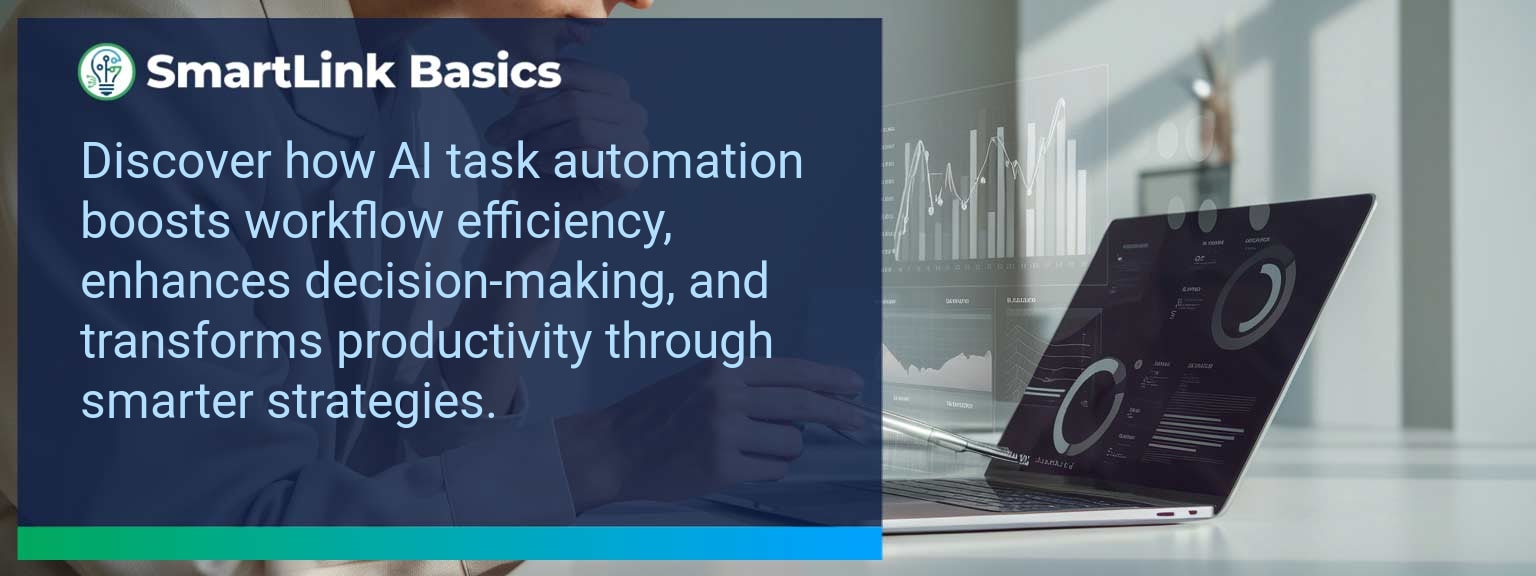AI-led automation now performs complex, adaptive tasks that once demanded significant managerial oversight. For sales leaders, the speed and accuracy gains directly impact revenue velocity and decision quality. At SmartLink Basics, we see AI task automation as not just an operational upgrade but a competitive imperative. This article examines how to harness these systems to redesign workflows, remove bottlenecks, and support higher-quality decisions. You’ll learn where automation delivers the most value, the frameworks to evaluate its impact, and the metrics to sustain results.
- Pinpoint high-impact tasks for AI automation using workflow mapping.
- Use data-driven process optimization to remove friction and redundancies.
- Deploy AI for predictive decision support on revenue-critical activities.
- Integrate automation tools without disrupting existing workflows.
- Track performance with leading, lagging, and quality metrics.
Identifying The Process Bottlenecks With AI Task Automation
Bottlenecks in sales workflows often remain hidden until they create measurable losses in cycle speed or conversion rates. AI task automation can surface these issues by examining data patterns, task dependencies, and time-to-completion metrics. This facilitates targeted intervention rather than broad, inefficient process changes. For example, a mid-market B2B sales team reduced lead response time from 36 hours to under 4 hours by automating initial email qualification. The improvement led directly to a higher conversion rate within one quarter. Establish a cadence for reviewing automation analytics to spot inefficiencies early. Prioritize fixes where delays directly affect deal progression.Leveraging Automation And AI Capabilities For Workflow Automation
Implementing AI systems effectively requires aligning automation capabilities with your revenue operating model. Sales leaders should look beyond task replacement and focus on intelligent task management that complements human judgment. Workflow automation tools can manage lead routing, forecast accuracy checks, and opportunity scoring while allowing sales reps to focus on complex negotiations. In one case, integrating AI for pipeline stage validation improved forecast accuracy by 12% over two quarters. This eliminated reliance on end-of-quarter fire drills to meet targets. Select platforms that allow phased integration. This approach reduces adoption friction and enables your team to quickly see operational wins.Achieving Efficiency And Accuracy Gains Through Intelligent Task Management
Efficiency gains from AI task automation are measured not just in task speed but also in process reliability. Machine learning automation enables decision support systems to recommend next actions based on historical patterns, increasing consistency in opportunity handling. Consider a scenario where AI audits CRM inputs every 24 hours, flagging incomplete opportunity data. This ensures higher-quality forecasting without administrative overhead. To sustain gains, set metric baselines before deployment. Use these as benchmarks to validate efficiency improvements against meaningful business outcomes.Projecting Future AI Potential In Sales Operations
The potential of AI task automation is expanding from structured workflows to adaptive, cross-functional process optimization. Combining AI-driven process maps with real-time market data could enable fully dynamic territory assignments or instant pivoting of prospecting focus based on macroeconomic signals. For competitive teams, the key will be scaling these capabilities while maintaining accuracy and transparency in decision-making. Invest in systems architecture now that accommodates evolving AI models and integration layers for future capability expansion.| Category | Metric | Definition | Target |
|---|---|---|---|
| Leading | Automation Adoption Rate | % of targeted processes successfully automated | 85%+ |
| Leading | AI Recommendation Usage | % of AI-suggested actions implemented by reps | 70%+ |
| Lagging | Cycle Time Reduction | Average reduction in days from lead to close | 15%+ |
| Lagging | Forecast Accuracy | Difference between predicted and actual revenue | ±5% |
| Quality | Data Integrity Score | Completeness and accuracy of CRM data entries | 96%+ |
| Quality | Reps Satisfaction Index | Survey-based index on effectiveness of automation tools | ≥ 4.2/5 |
Get the 90-day plan, coaching rubric, and dashboard template to operationalize AI in your enablement program.









